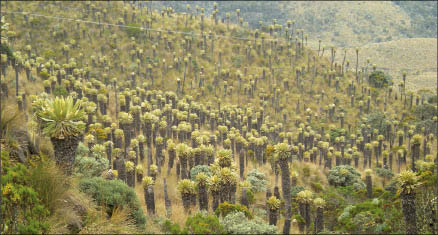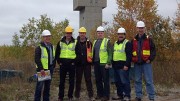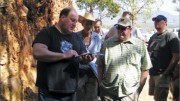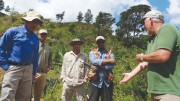The administration of former President Alvaro Uribe (2002-2010) opened the door to modern mining in Colombia. It was political foresightedness that is bearing fruit as various mineral projects advance to resource estimates and prefeasibility studies.
The large number of juniors entering Colombia, and their ability to raise money, indicates the country enjoys the warm embrace of the international exploration sector.
Indeed, up to US$300 million has been raised for exploration projects in Colombia since early 2010 and year-end 2010 proved to be particularly fruitful for fundraising as several companies secured financings on the back of Colombian assets: Sunward Resources (SWD-V, SNWRF-O), US$51.3 million; Galway Resources (GWY-V, GWYRF-O), US$25 million; Seafield Resources (SFF-V, SRLTF-O), US$15 million; and Alder Resources (ALR-V), US$3 million.
A raft of “newcos” also organized transactions propelling them towards TSX-Venture Exchange listings including Quia Resources (QIA-V), Solvista Gold and Touchstone Gold Holdings.
However, regulatory issues, particularly concerning environmental aspects, are causing uncertainty, the one thing miners cannot abide. Explorers are increasingly dissatisfied with the delegated authority that six Colombian states have over mining matters and the mining claims system that produces inconsistency in the application of the rules and inefficiency.
“The (national) mining ministry has to have the last word over mining matters. However, local government authorities are determining the rules of the game,” says the head of exploration for a major gold miner, who asks not to be named.
The general consensus is that the on-line mining licence database, much trumpeted by the government at its launch, has been a frustrating mess. It can only be accessed with the Mozilla Firefox browser, information is not up-to-date, and identification of free area is flawed – which contravenes the first rights given by the Mining Code as new concession applications are not automatically stored in the database and areas appear as though they remain available.
It’s a far cry from the quick, reliable, legally certain desktop application process explorers were promised.
“The mining licence system is atomized and information is out of date. There is no consistency or reliability in the information entered,” the exploration head continued.
Paradox of success
More worrying than administrative inconvenience is the uncertainty over the application of environmental rules. The mining and energy ministry has been successful in attracting exploration investment but, as companies advance to project development, they begin to test the regulatory framework of the 2001 Mining Code (Law 685) as amended in February 2010 (Law 1382). Here, a lack of coordination with the national environment ministry threatens to stymie gold mine development.
Colombia faces the shock of the new regarding what modern mining proposes, and much of what you hear is based on emotion rather than technical information. Modern mining offers a paradigm shift away from small-scale mining methods that offer precarious working conditions and rewards, contaminate watercourses with mercury and cyanide, and do not rehabilitate worked areas. However, this is the mining Colombia has lived with for centuries and is familiar with.
Pro and contra policy schizophrenia between the mining and environment ministries and general ambiguity is exacerbated by the fact that decision-making power often resides in local officials that are political appointees with a paucity of understanding of mining concepts and technologies.
“We need a reform to coordinate environmental policy, to unify criteria, that is more technical. The authorization of licences and permits should be at the national level, with supervision and control at the local level,” says AngloGold Ashanti‘s (AU-N) general manager Rafael Herz.
AngloGold’s La Colosa gold project and Greystar Resources‘(GSL-T, GSL-L) Angostura gold project have both been delayed by such issues and their resolution is a litmus test of whether Colombia really will be a mining country.
Greystar dimming
Greystar envisions average annual production at Angostura of 511,000 oz. gold and 2.3 million oz. silver over a 15-year mine life, according to its prefeasibility study. The project proposes an open pit with plant and other facilities to be located at a higher altitude.
Some of the plant facilities are due to be above 3,000 metres in what is known as a paramo, which is a unique Alpine meadow ecosystem, of which Colombia hosts most of the world’s total.
Objections to the project range from potentially damaging the ecosystem to polluting water resources through the use of cyanide heap-leaching. Opponents, such as Florentino Rodríguez of the Santander Society of Engineers, said in the national daily La Republica that the precautionary principle should be applied as “one single accident at the project could affect the paramo ecosystem.”
The paramo issue has been a public relations disaster for Greystar, a company that has spent considerable resources over many years developing sustainable economic development projects such as a nursery to provide the native plant species it will use for project rehabilitation.
Angostura was the subject of two prime-time TV news specials in Colombia in mid-January. The first focused on the Santurán paramo and the possibility that Colombia is about to allow one of the “worst environmental misfortunes” that will threaten endangered animals and potable water supplies to Bucaramanga and 20 other municipalities. The second program balanced this view by explaining the company will invest US$2.9 billion over the project’s life, and will employ 1,600 people in construction and 860 people directly once running and 3,440 indirectly. Importantly, several people in Vetas municipality supported the development for, amongst other reasons, its ability to sort out much of the district’s illegal mining problem that degrades the environment.
Regardless of such social-environmental issues, Greystar should have legal certainty about the conditions under which the project can proceed. The mining code prohibits mining in paramo areas but fails to define what a paramo is, or what constitutes mining activities (Exploration? Extraction? Infrastructure?).
“The paramos concept is totally ambiguous. It needs serious scientific technical studies of the social, economic and cultural aspects to define it. The environment ministry should do this but it has not, and that is why there is fighting,” says the unnamed exploration head.
Lacking technical studies, the government seems disposed to simply draw a line at a certain altitude and ban all mining activity above it. However, as paramos exist at different altitudes in different parts of the country, and as not all high-altitude terrain is paramo, the mining sector abhors this idea.
“The law is (in part) a legitimate attempt to protect a delicate ecosystem but basing it on a (semi-arbitrary) elevation is ridiculous as much of the ground above that elevation throughout the country does not contain that ecosystem,” says another exploration head of a TSX-listed explorer. “We need each paramo area to have clear scientific technical studies to determine what is paramo. This is very serious and if the limit is set at 3,000 metres and Angostura is rejected, it could mean our exit from the country,” the second exploration head continues.
Greystar initiated the project prior to the 2001 Mining Code and believes it is grandfathered into the previous mining code, which it says was implicitly confirmed during government official site visits.
As things stand, the company has to wait until March to find out what the gov
ernment will decide. But, as the influential Inspector General’s office recommended rejecting the mine plan and the mining minister commented in January that the project is “unviable,” it seems probable that Greystar will have to reconfigure it.
A key objection to operating near paramos is water-supply security. Here, the mining industry has failed to adequately communicate that technologies exist to prevent damage. Companies in Chile and Peru operate at up to 5,000 metres altitude in the Atacama Desert and do not capture water. Unfortunately, “there is tremendous ignorance in government and the NGOs about basic mining concepts, and they do not seek neutral scientific information about such things,” the second exploration head says.
Planning a small mining footprint looks increasingly advantageous in such circumstances.
“Building gold mines on a large scale is a new industry in Colombia, so we are staying underground to avoid making an open pit. Underground mining is something Colombia knows and we hope to stay close to what Colombia knows to avoid problems,” says Ari Sussman, president and CEO of Continental Gold (CNL-T), which plans to develop a 1,200-1,500 tonne-per-day underground mine at its Buritica gold project in Antioquia state.
Forest reserves
AngloGold faces an altogether different issue at its La Colosa gold project in Tolima state that exposes other cracks in mining policy implementation. Part of La Colosa is in a Forest Reserve – a protected area that Law 2 of 1959 says can be used for economic activity if a company requests that it be withdrawn.
Before 2008, withdrawal was not required for exploration only exploitation, but the interpretation changed and exploration now requires a temporary withdrawal permit. AngloGold began exploration before 2008 and had to request temporary withdrawal. Following long delays, it was successful in withdrawing 6.4 hectares from forest reserve areas.
If the project advances, the company will request permanent withdrawal and has to give compensation, but “the state has yet to define whether this should be cash or land, but the idea is to give land compensation,” says AngloGold’s Herz.
Inexact permitting rules then saw local environment regulator Cortolima sit on AngloGold’s water usage permit application, forcing suspension of the project.
Finally, in August 2010, AngloGold began trucking water to the site in order to restart resource definition drilling.
“The company decided to advance the project with rain water and purchased water that was brought to site, but it hopes to get approval to extract water from local sources within the next two months,” Herz continues. “We only need 4 litres per second that we reuse and re-circulate, and we have a monitoring program to show communities and authorities that exploration has no environmental impact.”
This permitting issue at La Colosa appears to be much more politically motivated than at Greystar’s Angostura, and may have more to do with AngloGold rather than mining development in general.
“AngloGold is only trying to permit exploration and there is no legal reason, to my knowledge, why it should be so difficult. The water issue is only an excuse, as there is no legitimate concern during exploration,” comments the exploration head of a TSX-listed explorer.
The twist in this tale is that the ambiguity of the 2010 Mining Code amendments could be superseded by chaos, as several plaintiffs have petitioned to have them struck for being unconstitutional.
Colombia’s constitution states that any law affecting indigenous mining rights requires prior consultation with indigenous groups.
“There was no such consultation prior to passing the 2010 amendments and, the Inspector General said, they have to be struck down. This would generate a lot of lawsuits against the state, for example, from those who have had concessions stripped under its provisions,” says the lawyer of a major gold miner, who also asked not to be named.
Uncertainty indeed!
– Based in Medellin, the author is a freelance reporter specializing in mining issues, and can be reached at paul.corresponsal@gmail.com.






Be the first to comment on "Colombia’s gold growing pains"